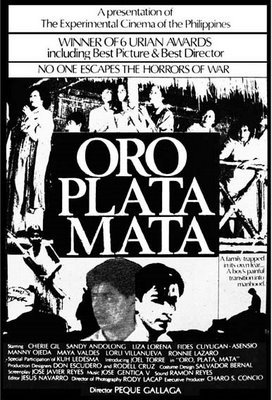The Great Restoration: Oro, Plata, Mata
Like the Filipino architectural
omen corresponding to Gold, Silver and Death, the Peque Gallaga directed and Jose
Javier Reyes written Oro, Plata, Mata
(1982) takes a triple dimensional story. The film depicted a filial exodus
around the gold, silver and death.
Oro
At this
dimension the setting is at the city where harmony exists. It was an imagery
mainly drawn from a usual elite society. The place was filled with merriment, as
if bad luck takes no space for the characters’ time. But the golden time is
broken when a ship sinks at Corregidor, Bataan.
Plata
Gold
becomes demoted to silver when they retreated to a hacienda. The stellar of the
urban life is converted to a more rustic comfort. At this moment, even the
elite’s options become limited. They are reduced to foreign circumstances which
were not present in the city.
Mata
As
the Japanese stretched powers over the country, the Lorenzo and Odeja clans
resort to plain bucolic house in the mountains for refuge. For both clans
descending from a high economic stature, such living is a bad luck. It appears
to be more of a curse as they are cloistered in a dystopian society. They turn
to be a self sustaining manor but it was reversed when some of their servants
plotted against them. Conflicts further surfaced. Characters transformed into
more unknown and unexpected psyches.
This
Oro-Plata-Mata pattern appears to be cyclical in nature since the ending
depicted a restored setting. But the restoration doesn’t parallel the former
Oro state. The characters apparently preserved a postwar stigma which is
psychologically inevitable.
Though
the story is rooted in the Japanese occupation, the war that reached the
characters is a fragmented placebo effect. It was Filipino versus Filipino. Where
does the conflict breakout? Their social classes. Some of the servants became
bandits by force of circumstance and epiphany. These bandits became defiant to
their masters to an extent of overcoming them. The elite family at this moment becomes
crippled lamely depending on their bare hands. Hands which were meant to play
mahjong and other recreations, not household work. This film becomes a caveat
for the ruling class that their posts are reversible in any point of time.
War
is a social equalizer. The top and bottom are scattered in different posts. The
Shakespearean notion that love is transcendental seems to fade out in the plot.
Love in this dystopian living is an unavailable commodity. The initial love
pairs are tossed to different partners.
A
classmate of mine posed a question, “What if we lived during that time?” Fathoming
that I have no guts to survive in such conditions, I replied a blank face. The
question until now consumes me. To witness actual bloodbath is something
traumatic what more if I were the one being bathed in blood. For me the film I not
an isolated case, it is a rampant occurrence happening not only in the
Philippines. Anne Frank’s diary would tell a European struggle at World War 2.
CS Lewis’s Narnia documented the children’s retreat to the British countrysides.
Auschwitz witnessed the inhumane part of man during this epoch. World War Two is something that leaves
an etch to everyman’s thought. This is too punitive that until now it becomes
the content of granny stories.
Star
Cinema should further widen the avenue of restoring the classic Filipino
movies. This is a divisive tool to build a more multifaceted culture among the
youth. I commend them for initiating a ‘could be’ Oro-period on our local classics. It is my fervent wish that
Philippines would be introduced to more creative movies not only capable of
making the audience laugh but arousing them think and act.























 Ian Harvey Claros
Ian Harvey Claros
0 comments:
Post a Comment